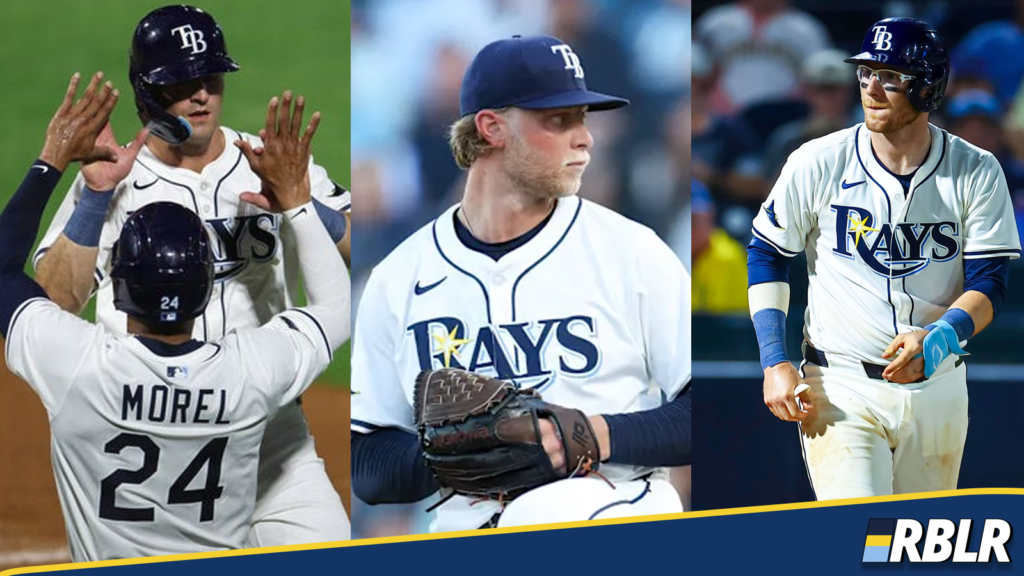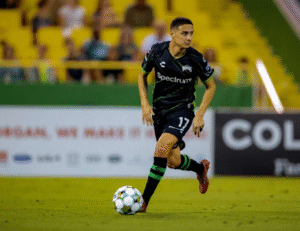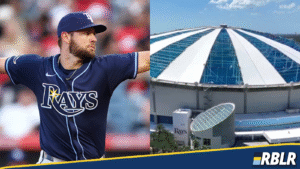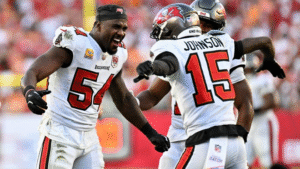RBLR Rays Roundtable #8 – Catching On To Some Early Trends

The Rays are about to begin a franchise-record 13-game homestand for the first time since 2005, and our writers have begun to take a look at some early trends this season and a brief history (and forecast) of Rays catchers.
Jake Shutters (@JakeShutters) : Focus On What You Can Control
The two most controllable things in baseball, in my opinion, are the swing decisions you make and being able to locate the baseball. Minimizing strikeouts and maximizing walks on offense and vice versa on defense generally are indicators of team success over 162 games.
Last year, the Rays were bad at striking out on offense, ranking 24th in K%, which is somewhat salvaged by being ranked 11th in BB%. This year, the Rays have seemingly put an emphasis on minimizing strikeouts, as they rank 11th in K%, while still walking at an above average clip, at 12th in the league.
The Rays pitching has generally been solid in years past, and 2024 was no different, as they ranked 11th in K/9 (8.78), and 5th in BB/9 (2.78). The team has improved on these already impressive numbers this year; they’re walking an astonishing 1.16 batters per game, ranking first in the league by a wide margin, as the second ranked team, the Red Sox, are walking 0.96 more batters per game than the Rays.
The pitching staff also improved on their strikeout rates so far, as they rank 9th in the league, striking out 9.44 per game. These improvements in controlling the plate are why the Rays are also 1st in the league in FIP, blowing away the Dodgers, who’s 2.70 FIP is an astounding 0.62 points greater than the Rays. The Rays pitching and hitting are giving themselves a chance to win every game, and controlling the zone more than in previous years will allow the Rays to flourish and look like teams of years past, where 3-4 runs per game can win you more baseball games than other teams.
Jacob Macauley (@raysfarmreport) : Morel and the Rotation
As I write this, the Rays have started their season 4-3 and have plenty to discuss. Let’s start with the player that’s impressed me the most so far. Christopher Morel has looked quite good to start the season, slashing .308/.438/.308, which might not be the most eye-popping slash line ever, but in the early stages of the season, Morel has shown plenty of growth as a hitter.
Morel has improved his hardhit%, barrel%, and chase%. It is still very early, and these things can fluctuate in a big way throughout just one game, but I am closely monitoring him this season.
The most impressive group overall has to be the starting rotation. Rays starters are off to a blistering start, leading the league in FIP at a whopping 2.09. They more than likely will not sustain a 5.7 HR/FB% throughout a 162-game season, but man, this rotation has just been nails.
Even in the last two games with Pepiot and Littell not showcasing their best stuff, they grinded and put together solid starts. This will be the most integral part of the Rays success this season, This group is talented enough to carry maybe a sub-par offense to the postseason, similar to the 2022 team.
This team feels a little different. I don’t know what it is, but it feels more like a traditional Rays team we are used to seeing. They will look to win on the back of their plethora of arms and will scrap offensively every game.
Dustin Teuton (u/FLBoy19) : Catching developments
The Tampa Bay Rays have long struggled to identify and develop consistent catching talent. Despite success in other areas, the Rays have been unable to find both offensive and defensive stability behind the plate, accumulating a 28.0 fWAR over 3,346 games since 2008 (12th worst) along with a 79 wRC+.
While players like Mike Zunino, Jose Molina, and Travis d’Arnaud have provided brief flashes of both defensive and offensive success, the position remains a major weakness. The lack of consistent production from catchers is highlighted by the fact that only six players—Zunino, Molina, d’Arnaud, Curt Casali, Wilson Ramos, and Jose Lobaton—account for nearly 75% of the team’s fWAR in only 33.6% of the team’s total games behind the plate in that timespan.
The Rays do have some intriguing catching prospects in their system, notably Dominic Keegan, Kenny Piper, and the young Nathan Flewelling.
Kenny Piper is a highly regarded defensive catcher. While his offense is limited, Piper has shown some power and could develop into a solid backup or defensive specialist at the MLB level. His power and defense lends itself to being an MLB backup catcher, who will strike out +28%.
Dominic Keegan, on the other hand, has a better offensive profile, posting a 138 wRC+ in AA last season. His defense, however, is still a work in progress, with questions about his arm strength and overall ability behind the plate. If he can continue to hit at a high level, he might compensate for defensive shortcomings, especially if MLB’s potential shift toward an ABS system de-emphasizes traditional catching defense.
Nathan Flewelling, the youngest of the trio, offers significant power potential but is still raw. His defensive and offensive development will be key, but if he progresses, he could eventually become a power-hitting option for the Rays. He will be one the more interesting prospects to watch this year as the 18 year old Canadian was aggressively assigned to Single A, so even a modest wRC+ production of 100-115 would be considered a massive boom for his development due to him being underaged for the level by 2 years.
As MLB evolves, particularly with the potential introduction of the ABS system, defensive acumen might matter less. This could benefit players like Keegan, whose offensive potential could offset defensive weaknesses. At worst, the Rays could have a platoon situation with Piper as a defensive-minded catcher and Keegan as an offensive option. Flewelling provides and additional development option although one that is likely 4-5 years out as a player from a cold-weather location. Though the Rays’ catcher position remains a question mark, their farm system provides hope. With continued development, they may finally find a solution to this long-standing issue.
The RBLR Rays Roundtable is a weekly collection of analysis, insight, and perspectives from a cast of writers assembled because of their unique backgrounds and experience. Check this space weekly for new updates and features covering the Tampa Bay Rays, the Rays’ minor league prospects, and more!







